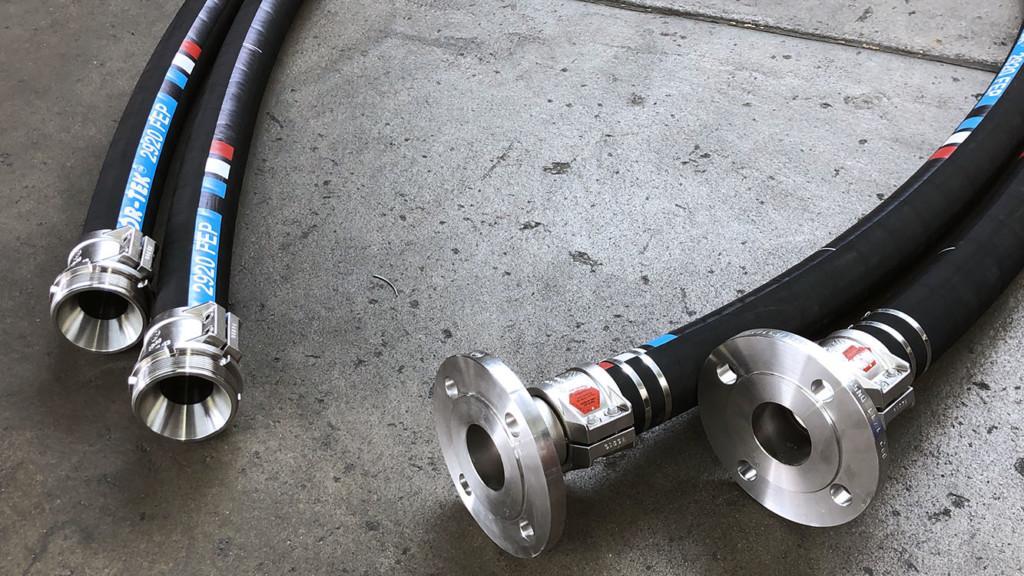
Transfer of industrial chemicals – how to choose the right, safe rubber hose?
In this article we take a look to the safety aspects, when transferring chemicals in an industrial environment.
How to make sure that you have the correct, safe hose for the chemical in question? What is the estimated life cycle of the hose and how to make sure that there’s no risks for unpredictable breakage? How to ensure your process optimization, efficiency and personnel’s safety, when handling chemicals?
Recent study (Jan 2020) reveals that there’s over 350 000 different chemicals in industrial use. The chemicals range from mild to lethal, water based to extremely corrosive acids – and anything between. According to the World Health Organization, chemical safety is the top priority for all those who manufacture, use, transport or dispose the chemicals. The responsibility includes the safety of people and nature. To this list we wish to include also expensive machinery, industrial goods and end-products.
Teknikum has over 30 years of expertise of designing and manufacturing on standard compliant chemical hoses. It is our calling and duty to help our customers to find the best solution from the perspective of safety and process efficiency.
Chemical Safety is achieved by undertaking all activities involving chemicals in such a way as to ensure the safety of human health and the environment.
It covers all chemicals, natural and manufactured, and the full range of exposure situations from the natural presence of chemicals in the environment to their extraction or synthesis, industrial production, transport use and disposal.
Source: World Health Organization
Step 1: Recognize the chemical
The first step towards selecting a correct hose is to recognize the chemical substance that is transferred. Do you have the chemicals SDS (Safety Data Sheet) at hand? You can get it from the manufacturer or you can search it from internet via SDS seach engines, such as MSDS Online, or you can look for the chemical data on ECHA Search for chemicals.
What is a chemical?
A chemical is a chemical substance whose 1) structure is known and 2) is named by its structure. Thus, a chemical may be an element, a chemical compound, or one of these forming a mixture.
Every chemical substance has a systematic name according to rules set out by the International Union of Pure and Applied Chemistry (IUPAC), the world authority on chemical nomenclature and terminology. This federation represents chemists in individual countries, as it is important that all countries recognise a chemical by the same name.
Many compounds are also known by their more common, simpler names, many of which pre-date the systematic name. For example, water is also know as Distilled water, Dihydrogen oxide (H2O) or Purified water.
A new analysis has revealed that up to three times as many chemicals are manufactured globally than previously thought. More than a third of these substances cannot be explicitly identified for intellectual property reasons or because of their chemical complexity.
The international team of researchers aimed to shed light on sources of chemical pollution by scrutinising all publicly available national and regional inventories of industrial chemicals. They found more than 350,000 chemicals are registered for production and use, almost triple that estimated by earlier surveys.
Source: ChemistryWorld
Step 2: What is the application?
What kind of requirements does the application set for the hose?
Clean / food contact
Do you need to be sure that the hose does not add any flavor, smell or color to the transferred chemical? In this case the hose needs to be food contact safe. The strictest regulation comes with German BfR (previously BGA). Also U.S. FDA regulation and EU regulation provide a framework for manufacturers.
If the hose meets the requirements, it’s marked with standard icon or there’s a mention on the datasheet.
Teknikum’s clean chemical hose is Teknikum MULTI-TEK™ SD UPE Clean with blue cover and Teknikum MULTI-TEK™ SD UPE Pro with black cover.
Also, take a look to our special Teknikum FOOD-TEK® Food quality hoses.
Oil-free chemicals / sulfuric acid / aging
EPDM (ethylene propylene diene monomer rubber) hose is compatible with basic substances, such as fireproof hydraulic fluids, ketones, hot and cold water, and alkalis. It is incompatible with most hydrocarbons – oils, kerosene, aromatic, gasoline, as well as halogenated solvents.
Benefits? EPDM provides outstanding resistance to heat, ozone, steam and weather. It can also withstand sulfuric acid up to ~65-70% concentration. Although the raw material is naturally an electrical insulator, our compound mix provides electrical conductivity for safety.
Note! The electrical conductivity of chemical hose assemblies must always be checked. Conductivity is determined by measuring the electrical resistance through the assembly from connector to connector. Electrical resistance must be measured from all installations for the transfer of flammable substances and from objects where static electricity is generated or used in potentially explosive atmospheres.
Teknikum provides hose Teknikum CHEMO-TEK® SD EPDM for this kind of use. The hose meets the requirements of EN 12115:2011 and is ATEX compliant.
Most chemicals / powdered solids / color pigments
UPE hoses made with chemical resistant UHMWPE-film (Ultra High Molecular Weight Polyethylene) are suitable for 98% of industrial chemicals. As lining material UHMWPE is odorless, tasteless, and nontoxic, as well as highly resistant to abrasion. The hoses meet the requirements of chemical hose standard EN 12115:2011.
Benefits? Our recommended multi-purpose hose for chemical industry. The inner lining is great in the transfer of powdered solids. For example, the substance of a color pigment is very fine and contagious. The UPE lining lasts this well and does not cause blockages in the transmission line. It can be also used for the transfer of dry tea due to the slippery surface.
Our high-quality hose series Teknikum MULTI-TEK™ offers suitable options for most industrial chemicals in various forms.
Oil-based chemicals / petrochemicals
Typically oil creates a challenge for rubber hoses. For oil based substances and petrochemicals we have developed the high-quality Teknikum FUEL-TEK® hose series.
These hoses meet the chemical hose standard EN 12115:2011 for transportation of all oil-based materials. Our hoses are suitable e.g. for gasoline, diesel oil and oil mixed water.
Bio-based chemicals / natural gas
These chemicals include e.g. bio-based aromas for fragrances and flavours, resins, lubricants, natural fertilisers, some industrial and household cleaners and solvents as well as drop-in biofuels and other fuels produced from biomass sources.
Typically RME (biodiesel) creates a challenge for rubber hoses, but some synthetic compounds are suitable. With this application a case specific check is always needed – please consult our lab for a suitability recommendation.
Teknikum recommends hose Teknikum FUEL-TEK® D Lypo for lead-free and E10 gasoline. For natural gas we offer Teknikum FUEL-TEK® SD Gas LPG/LNG.
Corrosive chemicals / concentrated acids
When transferring the most aggressive chemicals, hoses inner lining must be made out of PTFE (Polytetrafluoroethylene) or FEP (Fluorinated ethylene propylene). This kind of hose withstand for example fuels, solvents, oils and corrosive chemicals. FEP and PTFE both share the useful properties of low friction and non-reactivity, but FEP is superior to PTFE in applications involving exposure to detergents.
Teknikum offers Teknikum FLUOR-TEK® SD PTFE and Teknikum FLUOR-TEK® SD FEP.
Safety Data Sheets (SDS) include information about the properties of the substance or mixture, its hazards and instructions for handling, disposal and transport and also first-aid, fire-fighting and exposure control measures. The format and content of the safety data sheets are specified in REACH.
—
When safety data sheets are not required, the supplier must still provide sufficient information for safe use. If restriction or authorisation applies to any substance, the necessary details should be provided.
Source: ECHA European Chemicals Agency
Step 3: Optimize the life cycle, safety and operational environment
Physical properties of the hose
What are the dimensions of the optimal hose? What about the weight or bending radius? Is the hose needed for manual work or for fixed system?
By taking look into these features, you can optimize your hose selection. Teknikum hoses are made as standard sizes and lengths, but are also available with custom dimensions, shapes and features. Teknikum’s R&D and chemist team is at your service! We serve industrial plants directly in development projects as well as locally via official partner network.
Electrical conductivity issues
In its natural form, rubber provides electrical insulation. Some of Teknikum’s hoses are designed and structured in a way that the hoses provide ESD (Electrostatic discharge) protection.
Chemical hose standard EN 12115:2011 defines electrical conductivity with classes M, M/T, Ω, Ω/T. Teknikum chemical hoses electrical conductivity class and features are specified on the product datasheets.
Other requirements from operation environment
Is there dynamic stress from machines? Or wear and tear due to pulling the hose along the ground by workers?
In these situations take a look to the hoses cover. A corrugated surface is easier to bend and smooth cover is easier to fix to a pipe line. The both are suitable for outdoors.
With dynamic stress, focus on selecting the correct couplings and flanges to make sure that the pipeline is secured. We recommend EN 14420 -series couplings that are always specified according to hose product.
Note! It is very important from safety perspective and process reliability to have standard couplings. These fittings are tested for the pressure and match the hose’s diameter.
Still not sure, which hose to select?
If your application is new or you are hesitant, please contact our experts.
You can start by requesting a hose recommendation based on the chemical.
Contact us for personal support
Heavy process industry and mining industry

Jani Lampinen
Sales Manager, Industrial hoses BU
Teknikum Group Ltd
firstname.lastname@teknikum.com
+358 50 411 7810
Martti Jokela
Director, New Business Development
Teknikum Group Ltd, Central Europe
firstname.lastname@teknikum.com
+358 50 306 2172